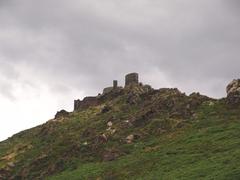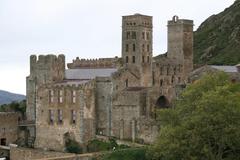Visiting Carrer Pujada al Puigrom in Roses, Spain
Publication Date: 23/07/2024
Introduction to Carrer Pujada al Puigrom
Nestled in the picturesque town of Roses, Spain, Carrer Pujada al Puigrom is a historical gem that invites visitors on a journey through time. From its ancient Greek origins to its Roman and medieval developments, this street encapsulates the rich and diverse history of Roses. Established around the 8th century BC by Greek settlers from Rhodes, Roses quickly became a significant hub for maritime activities due to its strategic Mediterranean location (Exploring Carrer Pujada al Puigrom - Historical Significance, Visiting Hours, and Travel Tips).
In the modern era, Roses has transformed into a popular tourist destination, celebrated for its stunning beaches, rich history, and vibrant culture. Carrer Pujada al Puigrom, with its historical layers, architectural marvels, and cultural events, offers an immersive experience for history enthusiasts and casual travelers alike. This comprehensive guide aims to provide valuable insights into the historical significance, visitor information, travel tips, and cultural highlights of Carrer Pujada al Puigrom, ensuring a memorable visit for all.
Contents Overview
- Introduction
- Ancient Origins
- Roman Influence
- Medieval Period
- Modern Era
- Architectural Significance
- Cultural Heritage
- Archaeological Discoveries
- Visitor Information
- Visiting Hours
- Tickets
- Nearby Attractions
- Accessibility
- Travel Tips
- Guided Tours
- Comfortable Footwear
- Photography
- Local Cuisine
- Cultural Events
- FAQ
- Conclusion
Exploring Carrer Pujada al Puigrom
Ancient Origins
Carrer Pujada al Puigrom is situated in the town of Roses, a location steeped in history dating back to ancient times. Roses, known as Rhode in antiquity, was founded by the Greeks from Rhodes around the 8th century BC. This settlement was one of the earliest Greek colonies on the Iberian Peninsula, playing a crucial role in the spread of Greek culture and trade in the region. The strategic location of Roses on the Mediterranean coast made it a significant hub for maritime activities.
Roman Influence
Following the Greek period, Roses came under Roman control in the 2nd century BC. Recognizing the strategic importance of the area, the Romans further developed it by constructing roads, aqueducts, and other infrastructure. The remnants of Roman villas and artifacts found in the area provide a glimpse into the life and times of this era. The Roman influence is still evident in the layout and architecture of the town, including the area around Carrer Pujada al Puigrom.
Medieval Period
During the medieval period, Roses continued to be an important settlement. The construction of the Citadel of Roses in the 16th century, a fortress built to protect the town from pirate attacks and invasions, marked a significant development in the town’s history. The Citadel, known as La Ciutadella, encompasses various historical layers, including Greek, Roman, and medieval remains. The area around Carrer Pujada al Puigrom would have been part of the town’s expansion during this period, reflecting the architectural and cultural influences of the time (Ciutadella de Roses).
Modern Era
In the modern era, Roses has evolved into a popular tourist destination, known for its beautiful beaches, historical sites, and vibrant culture. Carrer Pujada al Puigrom, with its historical significance, offers visitors a unique glimpse into the town’s rich past. The street itself is a testament to the various historical periods that have shaped Roses, from ancient Greek and Roman times to the medieval and modern eras.
Architectural Significance
The architecture along Carrer Pujada al Puigrom reflects the historical layers of Roses. Visitors can observe a blend of styles, from ancient ruins to medieval structures and modern buildings. The street’s layout and buildings provide insights into the town’s development over the centuries. Notable architectural features include remnants of ancient walls, medieval fortifications, and traditional Catalan houses.
Cultural Heritage
Carrer Pujada al Puigrom is not just a historical site but also a cultural landmark. The street and its surroundings host various cultural events and festivals that celebrate the rich heritage of Roses. These events often include traditional music, dance, and culinary experiences, offering visitors an immersive cultural experience. The preservation of historical sites and the promotion of cultural activities highlight the importance of Carrer Pujada al Puigrom in maintaining the town’s cultural identity.
Archaeological Discoveries
Archaeological excavations in and around Carrer Pujada al Puigrom have unearthed significant artifacts that shed light on the town’s ancient past. These discoveries include pottery, tools, and remnants of ancient structures. The findings provide valuable information about the daily life, trade, and cultural practices of the ancient inhabitants of Roses. The archaeological sites are often accessible to the public, allowing visitors to explore and learn about the town’s history firsthand.
Visitor Information
- Visiting Hours: The street is open to visitors year-round, but specific monuments and sites may have their own visiting hours. It’s advisable to check local listings or contact the Roses tourism office for detailed information.
- Tickets: While access to the street itself is free, some historical sites and guided tours may require tickets. Prices vary, so check in advance for the latest information.
- Nearby Attractions: After exploring Carrer Pujada al Puigrom, consider visiting La Ciutadella, the beaches of Roses, and other Roses historical sites. These attractions offer a broader understanding of the town’s rich history and cultural heritage.
- Accessibility: The street is accessible to most visitors, but some areas with uneven surfaces may pose challenges for those with mobility issues. Comfortable footwear is recommended.
Travel Tips
- Guided Tours: Consider joining a guided tour to gain in-depth knowledge about the historical significance of the area. Local guides can provide valuable insights and anecdotes that enrich your visit.
- Comfortable Footwear: The street and surrounding areas involve a fair amount of walking, often on uneven surfaces. Comfortable footwear is recommended to navigate the historical sites comfortably.
- Photography: The architectural and historical features of Carrer Pujada al Puigrom offer excellent photography opportunities. Don’t forget to bring your camera to capture the essence of this historical street.
- Local Cuisine: After exploring the historical sites, indulge in the local cuisine at nearby restaurants. Traditional Catalan dishes and fresh seafood are must-tries.
- Cultural Events: Check the local event calendar for cultural festivals and events happening during your visit. Participating in these events can provide a deeper understanding of the local culture and traditions.
FAQ
- What are Carrer Pujada al Puigrom visiting hours?
- The street is open year-round, but specific sites may have their own hours. Check with the local tourism office for details.
- Do I need tickets to visit Carrer Pujada al Puigrom?
- Access to the street is free, but some sites and tours may require tickets. Prices vary, so verify in advance.
- What nearby attractions should I visit?
- La Ciutadella, the beaches of Roses, and other Roses historical sites are highly recommended.
- Is Carrer Pujada al Puigrom accessible?
- Generally accessible, but some uneven surfaces may be challenging for those with mobility issues. Comfortable footwear is advised.
Conclusion
Carrer Pujada al Puigrom in Roses, Spain, is a historical gem that offers visitors a journey through time. From its ancient Greek origins to its Roman and medieval developments, the street is a testament to the rich and diverse history of Roses. By exploring the architectural features, participating in cultural events, and learning about the archaeological discoveries, visitors can gain a comprehensive understanding of the historical significance of this remarkable location. Download our Audiala app for more travel tips, and don’t forget to follow us on social media for updates!



